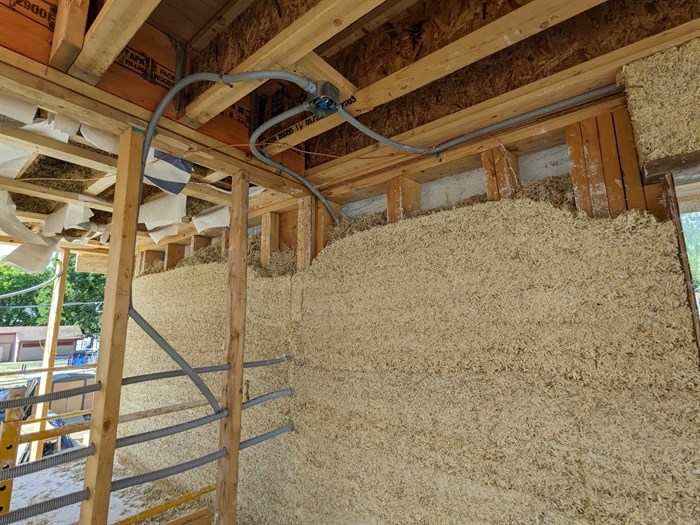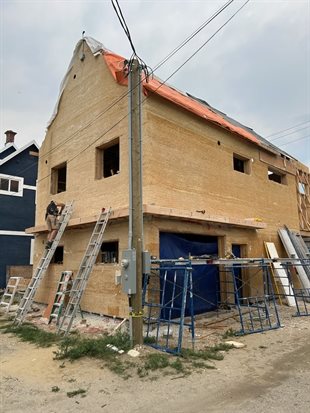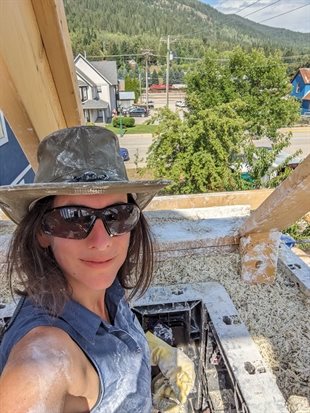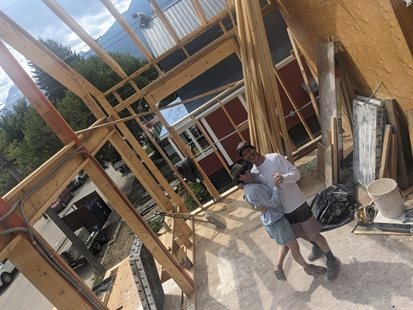Okanagan housing alternative proposes solution to wildfire, expense and energy
As the Okanagan faces drastic wildfire issues, a housing crisis, and a climate crisis, new innovations are high in demand.
Hempcrete, a new housing material that was recently introduced to the Okanagan, might be a new solution.
Hempcrete is a construction material the manufacturers say is fire-proof, eco-friendly, financially smart, healthy, and can be used by basically anyone.
“The only reason I can think of why people are not using it is because people aren’t aware of its existence yet, and hemp does have that weird stigma,” says Jaimie Miller-Haywood, co-owner of Haywood Designs.
“It’s chopped up hemp stock, added to cement mixture with lime and water which forms a paste that is used to fill in formwork around a wood frame construction. The house is framed the same as it would be conventionally and then you would just add formwork to the frame and fill the forms with bucketloads of hempcrete and once it's dried, the formwork is taken away and left with a monolithic structure,” Miller-Haywood says. “It replaces every single building envelope material, including paint, So, you don’t need sidings, insulation, plywood, vapour barriers, none of that is necessary with hempcrete. You eliminate roughly six steps in the building of a wall system, and it takes about the same amount of time to build a house out of hempcrete than it would to build a house out of traditional materials.”
Hempcrete does what any other material would do, from vapour control, insulation, pest control, and mould control, all the way to protecting the home from fire.
“It’s fire-proof, not just resistant… for our region, it’s probably the most important building technology in our lifetime,” says Miller-Haywood. Hempcrete is a non-combustible material which makes it a fire-smart material for building houses. “The fire rating is around 4 hours per inch, which is literally almost un-sparkable,” adds Lammie.
Further, its carbon-sequestering, insulation, and biodegradable properties make it a green alternative to any building material needed for a house.
As most plants do, hemp captures carbon dioxide and emits oxygen, making it carbon-sequestering. The unusual thing here is that it does it at a higher rate than most plants do and once it's turned into hempcrete it keeps doing it.
“It absorbs the same amount as the average Pentictonite contributes in carbon emissions annually; one acre of hemp offsets the carbon emissions of one Pentictonite, and it continues to do so once it’s turned into Hempcrete for up to 100 years,” Miller-Haywood says.
Derek Lammie and Miriam Manley are currently building a house out of hempcrete in Revelstoke and say the green aspect is what intrigued them.
“I discovered hempcrete on the Internet while researching sustainable building and design alternatives, and when I found that Derek was equally passionate about it, that is what brought the project into fruition,” Miriam says.
One of its most notable properties is the fact that it can insulate a house on its own.
“For insulation purposes, it’s far better than what we have on the market: You can achieve R52 insulation with hempcrete which means that you basically don’t need an energy-sucking heating or cooling system," Miller-Haywood says. "You eliminate the need for a large furnace or conditioning unit because the insulation value will keep you really warm in the winter and very cool in the summer because the heat can’t penetrate as quickly as it does with conventional building materials.”
Hempcrete thus reduces the need for fossil-fueled heating and cooling systems.
“Hemp and hempcrete are 100% of our insulation in this house,” said Lammie.
The material is also reusable or biodegradable once it is crumbled down. So, if one wishes to make renovations to the house, they can reuse the material or compost it.
“If you want to renovate your house, you can literally take a reciprocating saw into the part that you want to carve out, carve it out, crumble down the material that is removed, and you can reuse it in your rebuild or you can crumble it up and distribute it in your gardens or in the forest because once it’s broken down it’s 100% biodegradable,” Miller-Haywood says. “When it's whole, it’s waterproof, pest proof, mold proof.”
This material is also financially smart, not only because it saves people from having to invest in HVAC systems, but also because it is the only material that needs to be bought for the whole of house construction.
“At the moment, it’s looking like it’s coming in at the same price per square foot as it would for a traditional house, but as conventional building is becoming more expensive because of regulations becoming more focused on sustainability, it’s making sustainable building less expensive,” says Manley.
It is also an all-Canadian-made product. The downside? The material is more labour-intensive because the formwork must manually be filled in, but it can be done by anyone.
“You have to manually put the product into the form, but as it starts to gain traction, there will be more and more innovation to make it easier. But any construction crew can do it, in fact, anybody can do it: your own friends and family can help you put it together,” says Miller-Haywood.
It seems as though the labour involving hempcrete might be its only downfall.
“It’s one of those things where it’s hard work, it’s basic labour, so for people who are deterred by hard work, it might be a downside of the material,” says Lammie.
Haywood Designs is a Penticton-based house design company that promotes the benefits of Hempcrete which are notable, especially in the Okanagan environment and they offer hempcrete designs.
Miriam and Derek are building their house through the company they own and operate, Wellwood Custom Homes. Wellwood Custom Homes is a registered residential home builder with BC housing in Revelstoke.
To contact a reporter for this story, email Gabrielle Adams or call (250) 863-7592 or email the editor. You can also submit photos, videos or news tips to the newsroom and be entered to win a monthly prize draw.
We welcome your comments and opinions on our stories but play nice. We won't censor or delete comments unless they contain off-topic statements or links, unnecessary vulgarity, false facts, spam or obviously fake profiles. If you have any concerns about what you see in comments, email the editor in the link above. SUBSCRIBE to our awesome newsletter here.







